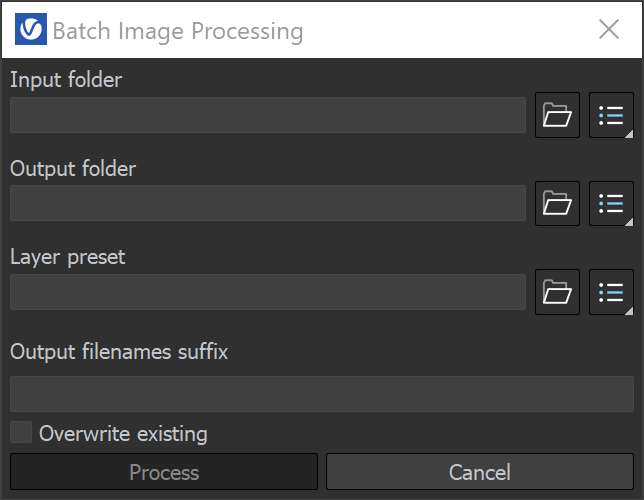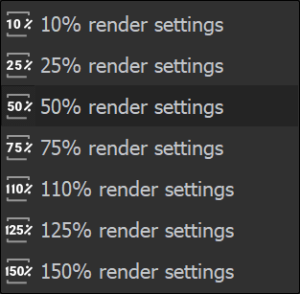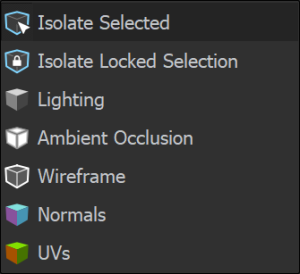Page History
...
Menu | Menu Options | ||||||||||||
|---|---|---|---|---|---|---|---|---|---|---|---|---|---|
File | Save current channel – Saves the currently loaded channel to an image file format. Note that color correction layers are not saved. Save all image channels to separate files – Saves all the render elements to separate files. Select the options () button to open a menu with more settings. Save all image channels to single file – Saves the image to a single multi-channel EXR or .vrimg file. Load image – Opens an image file to be previewed in the V-Ray Frame Buffer. Batch image processing – Allows processing of multiple .vrimg files with the same layer tree changes at the same time. Upload image to Chaos Collaboration – Uploads an image to Chaos Cloud Collaboration for sharing and commenting.
|
Save VFB color corrections to render elements – When enabled, all color corrections are saved to the render channels (as opposed to only the RGB and effectsResult channels). | |||||||||||
Batch Image Processing Input folder – Specifies a path to start images. Output folder – Specifies a path for the output images. Layer preset – Specifies a layer tree corrections preset. Output filenames suffix – Specifies a suffix added to the output image filenames. Overwrite existing – Enables overwrite of existing files with the same name in the output folder. | |||||||||||||
Render | Start interactive rendering – Starts IPR. Abort rendering – Stops Cancels the current rendering. Render – Starts rendering. IPR Debug Shading – Enables the Debug shading/Isolate selected options in IPR. The submenu gives access to the following modes: Isolate Selected – Renders only the selected object(s), while the rest of the scene is rendered black. You can also select material or texture nodes to isolate all objects with the assigned shader; | ||||||||||||
Image | Follow mouse – Renders the closest bucket found to the mouse pointer, when using the bucket image sampler. If the progressive sampler is used, V-Ray samples the closest pixels to the mouse pointer. Follow mouse – Drag the mouse over the VFB while rendering to change what part of the image is sampled first; Copy current channel to clipboard – Copies the current channel to the clipboard. Duplicate to host frame buffer – Creates a 3ds Max virtual frame buffer copy of the current VFB. Clear image – Clears the contents of the frame buffer. This is useful when starting a new render to prevent confusion with the previous image. | ||||||||||||
View | Display color space – Specifies the color space, in which the image is displayed. None – Does not specify a color space; Zoom VFB – Zooms in/out the rendered image in the VFB. Zoom 50% – Zooms out to 50%; Channels – Chooses which channels to see. View red channel – Displays the red channel; Test resolution – Enables test resolution in VFB. The submenu allows choosing a percentage of the render resolution to set as the test resolution. You can choose between 10%, 25%, 50%, 75%, 110%, 125% and 150%. Note: This only affects V-Ray and does not affect the native 3ds Max test resolution setting found under 3ds Max's Render Setup dialog. Color clamping – Opens the color clamping submenu options: Force color clamping – Forces color clamping; Use pixel aspect – Enables visualization of the pixel aspect ratio. Flip – Mirrors the image in the VFB. This is a view only option, the flipped image cannot be exported. This function is only active while holding the menu button or the hotkey for the corresponding type of flip. The effect does not interrupt interactive rendering. Flip horizontally– Mirrors the image horizontally. Flip vertically – Mirrors the image vertically. Panorama View – Shows the image in 360° view. Show History – Shows the History panel. Show Layers – Shows the Layers panel. | ||||||||||||
Options | VFB settings – Opens the VFB Settings window where you can adjusts settings for Render View, Render Region, History and Layers. | ||||||||||||
...
| Locks the mouse pointer coordinates and displays information for the selected pixel. | ||
| Shows corrected colors. | ||
Shows the V-Ray Log which contains messages about the render process. The V-Ray Log is also available in the Log tab. | ||
| Displays the red channel. | ||
| Displays the green channel. | ||
| Displays the blue channel. | ||
| Displays the Alpha channel. | ||
Saves the image to disk. Select and hold the icon to bring up the submenu: Save current channel – Saves the current channel to an image file format; | ||
| Clears the contents of the frame buffer. This is useful when starting a new render to prevent confusion with the previous image. | ||
| Renders the closest bucket found to the mouse pointer, when using the bucket image sampler. If the progressive sampler is used, V-Ray samples the closest pixels to the mouse pointer. With this option enabled, you can right-click on the image and select Lock bucket starting point to lock the bucket (or sampling) starting point. | ||
Enables/disables test resolution in the VFB. Select and hold to bring up the submenu to select the percentage of the render resolution to set as the test resolution. Note: This only affects V-Ray and does not affect the native 3ds Max test resolution setting found under 3ds Max's Render Setup dialog.
| ||
| Renders regions in the VFB. See the Render Region section for more information. | ||
Enables the Debug shading/Isolate selected options in IPR. Select and hold to choose between the different modes: Isolate Selected – Renders only the selected object(s), while the rest of the scene is rendered black. You can also select material or texture nodes to isolate all objects with the assigned shader; | ||
| Starts IPR. If there is more than one camera in the scene, hold left mouse button to display a list of the available cameras. | ||
| Stops the current renderingCancels the current render. When the render is cancelled, the Denoiser is not applied or saved, equivalent to the behavior of the Cancel button in the Rendering window. | ||
Starts rendering. If there is more than one camera in the scene, hold left mouse button to display a list of the available cameras. When pressing Shift + this button, starts Render last and the last rendered viewport/camera is rendered. | ||
| Pauses interactive rendering when using V-Ray GPU. | ||
| Refreshes interactive rendering. | ||
...
| Mouse | Description |
| Mouse wheel | Zoom in/Zoom out |
| Double-click left button | Zoom to 100% |
| Middle button dragging | Pan (hand tool) |
| Ctrl+Shift+Left click | Zoom in the rendered image |
| Ctrl+Shift+Right click | Zoom out the rendered image |
| Keyboard | Description |
| Global | |
| H | Show/hide history |
| P | Show/hide only layers tree |
| Ctrl+L | Show/hide whole right panel |
| F11 | Toggle full screen |
| S | Show/hide VFB settings |
| History/Render View | |
| E | Enable history A/B/C/D compare mode |
| Q | Enable history A/B horizontal compare mode |
| W | Enable history A/B vertical compare mode |
| N | Edit a note in VFB History panel |
| 1-9 | Load the respective image from the VFB history |
| Layers/Property Panel | |
| Ctrl+Y | Redo various actions related to layers such as create, delete, reorder, or modify a layer. |
| Ctrl+Z | Undo various actions related to layers such as create, delete, reorder, or modify a layer. |
| Layers | |
| Del | Delete layer |
| Message Log | |
| Esc | Close search |
| Ctrl+F | Activate the Search field in Log tab |
| Return | Find next |
| Shift+Return | Find previous |
| Render View | |
| Esc | Abort Cancel render |
| Ctrl+C | Copy the VFB image to the Windows clipboard; the image is copied exactly as it appears on the screen (meaning sRGB/LUT/OCIO etc. corrections are applied). The full resolution image is copied to the clipboard, even if the VFB view is zoomed in/out. |
| Ctrl+O | Load image |
| L | Lock the mouse pointer coordinates and display information for the selected pixel, i.e. activate the Lock pixel info coordinates button. |
| Arrow keys | Pan image left, up, right, down |
| A | Switch to Alpha channel |
| B | View Blue channel |
| G | View Green channel |
| R | View Red channel |
| Page Down | View next channel |
| Page Up | View previous channel |
| * | Zoom to 100% |
| + / = | Zoom in |
| -/_ | Zoom out |
| F | Fit region or whole image in the VFB |
| M | Hold to flip image horizontally |
| Shift + M | Hold to flip image vertically |
...




